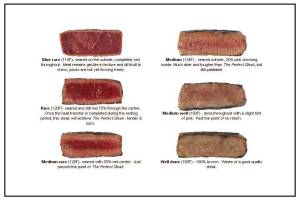Cooking Temperatures
Chicken, Turkey, Duck
| Temperature | USDA Safe | Practical |
| Whole | 165° | 165° |
| Breast | 165° | 165° |
| Thigh | 165° | 165°-175° |
| Ground | 165° | 170°-175° |
Beef, Veal & Lamb

When determining the temperature to cook your meat to, there's a crucial distinction to be made between whole muscle cuts and ground meat. The food scientist Harold McGee explains:
“… meats inevitably harbor bacteria, and it takes temperatures of 160 degrees Fahrenheit or higher to guarantee the rapid destruction of the bacteria that can cause human disease — temperatures at which meat is well-done and has lost much of its moisture. So is eating juicy, pink-red meat risky? Not if the cut is an intact piece of healthy muscle tissue, a steak or chop, and its surface has been thoroughly cooked: bacteria are on the meat surfaces, not inside. ”
In other words, with whole cuts of meat it is the external temp, not the internal temp, that must exceed 160 degrees Fahrenheit. Normal cooking methods — sauteing, grilling, roasting, braising, etc. — raise surface temperatures far above 160 degrees Fahrenheit. (To get a sense of this, consider that meat only begins to brown at 230 degrees Fahrenheit.) People very rarely get sick from rare or medium-rare meat. Overwhelmingly, people get sick from the way meat is handled in the home: from cross-contamination, lack of cleanliness and holding meat at dangerous temps. Internal temperature should be the least of your worries. more
| Temperature | USDA Safe | Practical | Finger Test |
| Rare | 125° | Fore | |
| Medium Rare | 130°-135° | Middle | |
| Medium | 135°-140° | Fourth | |
| Medium Well | 145° | 140°-150° | |
| Well | 155°+ | Pinky | |
| Ground | 160° | 160° |
Finger test
Lightly touch thumb to finger on same hand. Feel the fleshy base of the thumb with the other hand. That's the same feel the meat will have.





Pork
| Temperature | USDA Safe | Practical |
| Medium Rare | 145° | 145° |
| Medium | 150° | |
| Well | 160° | |
| Ground | 160° |
Seafood
Seafood cooks quickly and is usually thin. This means that it can be tough to measure with a thermometer, so use the visual indications.
| Type | USDA Safe | Cook Until |
| Fin Fish | 145° | Flesh is opaque and separates easily with a fork. |
| Shrimp, Lobster & Crab | Flesh is pearly and opaque. | |
| Clams, Oysters & Mussels | Shells open during cooking. | |
| Scallops | Flesh is milky white or opaque and firm. |
